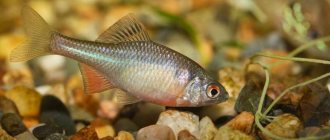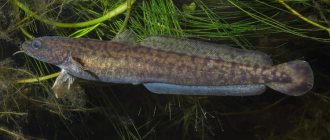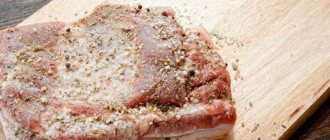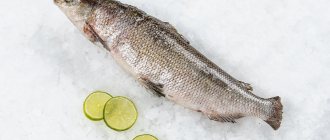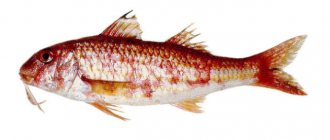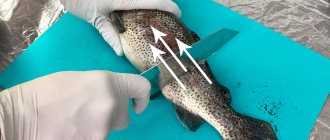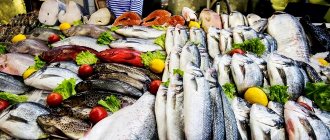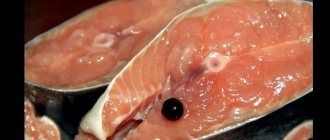Poisonous or not
When threatened, ball fish release a deadly poison, tetrodotoxin, which blocks the release of sodium in all cells of the human body. The salt cannot escape from the shell, resulting in muscle paralysis. A person dies from cardiac arrest, since the myocardium is equipped with a powerful muscle. The specimen received its second name from the Japanese - fugu. If the fish is inflated, it means the presence of fear or aggression. It is protected by thorns and needles that contain poison.
Interesting things about urchin fish
• Spikes are highly modified scales that form a protective chain mail on the fish’s body; • Residents of one island in the Pacific Ocean made military helmets from the dried bodies of urchin fish; • Urchin fish are eaten in some countries and are considered a delicacy. But they can be eaten only after they have undergone special cooking. But such a delicacy can be very dangerous. If urchin fish is prepared by an inexperienced cook, it may turn out to be poisonous; • In the Far East, dried urchin fish or products made from their skin, such as lampshades, are sold. Chinese lanterns are also made from dried fish in a swollen state.
Habitat
Lives in the Sea of Japan, Atlantic and Indian Oceans. A popular species is called Diodon long-nosed; no toxic compounds were observed in the needles, but there are a lot of toxic substances in the fish’s body. Fans of exotic fish that swell like a balloon are bred in an aquarium. The size reaches up to 16 cm, lives up to 6 years. In the wild, the ball fish grows up to 1 meter within 25 years.
Loves salty, clean waters where many small fish and plankton live. It prefers to lead a hidden, secluded lifestyle, so it rarely encounters predators. The acquisition of an inflated form indicates aggression and insurance. A fish with spines and spines has different names: ball, ball, brown rocktooth. It received its main name from Japanese cooks due to its toxicity. An inflated fish does not pose a danger to humans if it is picked up by the tail.
Description of hedgehog fish
Most often, these fish have an average length of 30 centimeters, but they can reach a maximum length of 90 centimeters. The entire body is strewn with spines up to 5 centimeters in size.
The color of most individuals is light, but dark spots are scattered throughout the body. The head is blunt, round in shape.
The hedgehog fish is armed with powerful jaws that look like a beak.
Inside the beak there are not teeth, but sharp plates. With the help of its beak, the hedgehog fish is capable of chewing mollusk shells and corals.
The spines are modified scales that can be mobile in some species and rigid in others. The fins are small and weak, so these fish cannot swim quickly against the current. But, despite their slowness, hedgehog fish can stop and swim in any direction.

Hedgehog fish (Diodontidae).
Home maintenance
Thorn fish feels great in a 50 liter container. If two individuals live in the aquarium, then you need to increase the volume of liquid by the same proportion. Under comfortable conditions, sexually mature individuals reach parameters of up to 15 cm. In order for the spiny fish to develop quickly, you need to change the water daily, add a little sea salt, and place an artificial aeration device in the vessel.
Ball fish living in fresh water for a long time will quickly pick up an infection. Salt should be added in a proportion of 15 grams per 20 liters. A fish that swells when in danger can live in an aquarium for more than 3 years.
Puffer fish can live in an aquarium.
For quick adaptation, artificial algae and stones can be placed in the aquarium. The individual likes to hide from prying eyes. It is necessary to prevent air deficiency in water every day; compliance with temperature conditions. Urchin fish should be kept in an environment of +28 degrees. It is recommended to change 10% of the fluid every 24 hours a day. If a round, spiny fish puffs up strongly, this indicates anxiety and a warning to the individual, which looks both cute and scary.
Lifestyle
A predator cannot be called a civilian. He behaves quite aggressively. To prevent the hedgehog fish from eating other inhabitants of the aquarium, you need to place it with its relatives.
Pufferfish prefer to hide in the shadows. They are active in the evening and at night. The hedgehog fish often hides in algae. If there are caves in the aquarium, she swims into them.
Tetradon becomes ready to reproduce when it turns 1 year old. It is better not to place 2 males in one mini-reservoir, as a fight for territory will begin. For propagation to be successful, you need to plant algae, hornwort or cryptocoryne. To stimulate spawning, the Pufferfish is fed snail and meat. Individuals reproduce at a temperature of + 28 degrees.
The hedgehog fish should be placed in an aquarium with its relatives, as it can eat other fish
It is important to know how to distinguish a female tetradon from a male. The female specimen is larger and has pronounced spots on its body. At the beginning of spawning, the male chases the female. If she does not behave aggressively, the couple swims to the bottom and hides behind thick algae.
What does it eat?
You cannot start introducing dry food and supplements into your diet. If the immune system is weakened, the ball fish may die. The poisonous shar fish prefers to feast on fresh algae; it does not mind eating a few snails, worms, fry, or a piece of beef liver.
You cannot breed puffer fish with small fish in the same aquarium, otherwise the former will eat the latter. If fry appear in the container, for normal growth and development you need to pour organic sand on the bottom; small individuals like to sharpen their teeth. The prickly, round individual looks like a ball during a fight, getting food. A fish that inflates like a balloon loves silence and moves with the school.
Description and features
The appearance of these fish greatly distinguishes them from other species. They have a short elliptical body. All representatives of the breed have bulging eyes. Gill slits consist of two openings. Since the ball fish is a predator, it has a special mouth structure. The cavity includes four plates that help crush food. With the help of fins, these fish carry out various maneuvers: they move backward, easily change directions and hover in one place. The main protective function is performed by special spines that replace traditional fish scales.
https://youtu.be/8j2A3DU-4o8
We recommend reading
Aquarium fish for beginner aquarists
The ability to inflate is another striking feature of the fish. It's all about an elastic stomach. At the slightest danger, the fish draws water into it. This makes her body round, like a ball. There is also gas in the stomach. What about breathing? Scientists have put forward two versions: according to one, the fish continues to breathe through its gills, and according to the other, it is forced to hold its breath. Australian experts experimentally proved the first version.
Scientists also noted that the respiratory rate increases 5 times compared to the resting period. For fish this is a colossal expenditure of energy. It takes several hours for breathing to return to normal.
The danger of flavors
Japanese chefs have a special license to prepare this type. People who wanted to cook the delicacy themselves with moderate skills died from muscle paralysis.
The poison is mainly found in the skin, liver, spleen, gall bladder and caviar. With any damage to these organs, a toxic substance leaks out of the cells and even in micro quantities can cause paralysis.
When fish is properly processed, poisoning of the body does not occur after consumption. The cooking technique itself was developed by Japanese chefs, who, after decades, shared it with Russian specialists.
Description of stickleback reproduction
Fish spawning time is most often April-May. A few days before this, they change color - they become brighter. Their fertility is low - only 100 eggs laid.
The peculiarity of this species is that the stickleback fish equips a nest for laying eggs. And it is not the female who does this, but the male. He digs a hole in the sand with his mouth, then transfers pieces of silt, algae, grass there and lays out the bottom. For strength, all this is held together by mucus secreted from the sides of the fish. The ball-shaped nest has two holes located opposite each other. Sometimes it is half hidden in the mud and is difficult to detect.
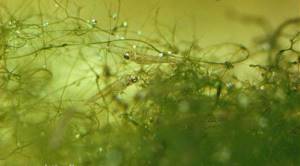
After the place is equipped, the male returns to the flock, selects a female ready for laying and drives her into the nest through one of the holes. The female lays eggs and exits into another hole, after which the male enters the nest and fertilizes the laid eggs with milt.
After this, the male remains at the nest and guards it, keeping enemies away. This continues for about two weeks until all the young fish that have hatched from the eggs leave the nest. And before that, he closely monitors the offspring, not allowing them to go far from the nesting site.
Rules for cleaning the most poisonous specimen from Japanese chefs
Often exotic dishes are ordered by people who prefer to tickle their nerves. Professional chefs of Japanese cuisine sharply and precisely clean the ball fish from the fins and vocal apparatus (the possibility of poison getting into the fillet is excluded). Then the poisonous organs are carefully and slowly removed, the fillet is cut into thin, identical pieces, and the raw materials are washed under running water. Normally, the fillet looks like thin transparent slices and tastes like chicken.
Every year in Japan, hundreds of people die after eating fugu fish, since the market is not interested in cooking knowledge, sellers take most of the money they can get.
Attention, the dishes are given for general information, in order to prepare poisonous fish professionally, you must receive formal, additional education in order to avoid poisoning. Otherwise, before eating the food, you should make a will and say goodbye to your family and friends. Many deaths have been recorded in eastern countries due to improper preparation of poisonous fish. Puzzlingly, today there is no government control to identify the illegal sale and culinary processing of life-threatening products. There are many names for Japanese bubble fish dishes.
Round view of fish
Cod . The sea fish is quite impressive in size. It reaches about a meter in length and weighs from 20 to 35 kg. Differs in varieties depending on habitat. On the shelves there are mainly Atlantic and Pacific cod. Cod contains the largest amount of valuable substances in its composition. High nutritional value and low fat make it a balanced diet for people leading an active lifestyle. The taste of cod can be incomparably revealed through various culinary actions. Frying, baking, stewing are the main cooking methods. Exquisite marinades can elevate cooked cod to the main positions on a restaurant menu. Negative factors of eating cod include the ability of fish to accumulate mercury salts in the process of life.
Mackerel . Sea fish, common on store shelves. The main place where mackerel is caught is the waters of the Pacific Ocean. The unique composition of mackerel meat is the complete absence of carbohydrates. There are exactly 0 carbohydrates per 100 g of product. At the same time, fish contains all useful groups of vitamins, microelements, and healthy fatty acids. Useful for people with high calorie consumption. Women get the niacin and phosphorus they need for health. For children, mackerel is ideal for introducing complementary foods. The relative harm of mackerel lies in the popular method of processing it – smoking. This increases the fat content of the fish. Therefore, smoked mackerel is recommended to be consumed in reasonable quantities.
Perch . A popular and widespread species with a wide habitat. The size of the fish depends on the geography of catching. In warm waters, individuals reach one meter. In our country, a smaller size of about 20 cm is common. Perch meat has a delicate creamy taste. The absence of large bones and the small number of thin ones, as well as the healthy composition, are not a reason for frequent consumption of perch. The hard scales and sharp, prickly fins of the fish neutralize the taste and nutritional properties of this species. Perch is easy to prepare. Since perch is the driest fish compared to other species, the fish can be deliciously served with various sauces. The disadvantage of the fish is the prickliness of the fins and the density of the scales as an inconvenience in cutting. However, the problem can be easily solved by dipping the fish in boiling water for a few minutes. After this, the fins can be easily cut off with kitchen scissors.
Som. One of the largest representatives of river fish species. It is extremely popular among chefs due to its large size and complete absence of scaly cover. The sedentary lifestyle of sedentary river fish affects the composition. Delicious catfish meat has high fat content and low calorie content. The high content of vitamins B, E, fatty acids, potassium, and phosphorus make catfish meat an excellent dietary product. It is useful for athletes, pregnant women, and children as complementary foods. According to the nutritional standards of meat, catfish successfully replaces pork and beef. Catfish is popular among residents of our country in any form. Fans especially respect kebab in a light marinade. Due to the increased fat content, it is recommended that catfish meat be consumed with caution by people with diseases of the cardiovascular system and hypertensive patients.

- Political scientist Bredikhin: Russia will send troops to Donbass in the event of an attack by Ukraine on the DPR and LPR
- Avia.pro website: Russian Aerospace Forces aircraft could have destroyed mercenaries from NATO countries in an underground tunnel in Syria
- World War III is on the doorstep. What is she like?
- Avia.pro: Russian Su-35 chased an American F-18 in the skies of Syria and simulated its destruction
- The domestic 5G network fell into the frequency range used by NATO aviation
- Pies in the oven: 12 tips on how to bake correctly
Become a member of the CLAN and every Tuesday you will receive the latest issue of “Arguments of the Week” with a discount of more than 70%, along with exclusive materials not included in the newspaper. Get premium access to a library of the most interesting and popular books, as well as an archive of more than 700 published issues for FREE. In addition, you will have the opportunity to benefit from free legal advice from our experts for a whole year.
- Enter your email address, then select any convenient payment method for your annual subscription
- Scan the QR. In the Sberbank Online application that opens, enter the annual subscription cost (490 rubles). Then send the confirmation code by email
Or

Fish stew
- Fish fillet 500 g;
- Potatoes -200 g;
- Beetroot - 1 piece;
- Cabbage – 200 g;
- Zucchini – 1/3 pcs;
- Tomatoes -200 g;
- Butter - 1 tbsp;
- Onion -2 pcs;
- Bell pepper – 1 piece;
- Dill parsley to taste;
- Sour cream – 2 cups;
- Broth 100 ml;
- Bay leaf - 1 piece;
- Salt to taste.
Preparation
- Chop the pepper and onion into half rings.
- Fry with cabbage and tomatoes (pre-cut).
- Peel 1/3 of the zucchini and grate on a coarse grater.
- Cut the fillet into slices.
- Place the vegetables in the pan and place the fish pieces in the middle.
- Add chopped dill, parsley, bay leaf.
- The top should be lined with tomatoes.
- Pour a glass of broth, after adding sour cream.
- Cover with a lid and place in the oven for 2 hours (on low heat).
Cooking time 2.5 hours.
Cooking time – 2 hours.
Number of servings – 10.
Calories - 776, fats -82, carbohydrates - 67, proteins -1.9.

Flat varieties
The species has a characteristic feature: the original flattened body shape. Their main bones radiate from the back in the form of rays directed towards both sides of the ridge. It seems as if the entire upper part of this creature is its back, and the lower part is its stomach. However, it is not. Most of the surfaces are occupied, oddly enough, by the sides. Some representatives of this type of fish can reach up to two meters in length. You should understand the names of flat fish, which are the most popular today:
- flounder,
- halibut,
- whitefish,
- tilapia.
Let's look at the brightest representatives of this family.
Flounder
It is noteworthy that there are approximately 500 species of flounder fish on earth. Their habitat is very diverse: they are found both in hot tropical waters of seas and oceans, and in icy arctic ones. As a rule, they live in coastal areas, but some species can enter rivers, rising quite high in them. Some species are found at very significant depths.
There are about 30 species of flounder in the Russian seas. There are different names for flounder: salt, sole, gloss, diamond, limand. Her body looks flattened on both sides, she can gain weight up to 3 kilograms. In the upper part, where the eyes are located, the color is lighter and brighter. Mostly found at the very bottom. It is found in the Azov, Black, Bering, Okhotsk and Mediterranean seas, as well as in the waters of the Atlantic Ocean. Spawning takes place in early spring at a depth of 150 m .
One cannot help but appreciate its excellent taste, which is why the fish is caught at a very fast pace. This leads to a sharp decline in flounder populations in many seas.
Halibut
Belongs to the order of predators. It feeds on pollock, cod, flounder, and a variety of mollusks. The lifespan of halibut is about 30 years. It is one of the valuable species of commercial fish, as a result of which it is caught in unusually large quantities.
It is found in the northern Pacific and Atlantic oceans, as well as in the Seas of Okhotsk and Barents. It is divided into such varieties as black, common, Asian and American arrowtooth halibut.
tilapia
Belongs to a freshwater species. Lives at the bottom of tropical reservoirs. Tilapia is not a picky eater and feeds on all kinds of organisms in the water.
In addition, tilapia is artificially bred in North American, African and Asian countries. Its meat is rich in protein, lean, and has an excellent taste. For this, she was nicknamed the “royal perch.”
